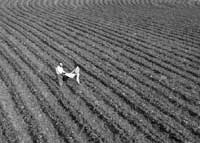Hot conversion
 the large-scale conversion of forests to croplands in the midwestern usa over the last 100 years has led to a measurable cooling of the region's climate, shows the study conducted by Gordon Bonan, researcher at the National Centre for Atmospheric Research ( ncar ), in the us .
the large-scale conversion of forests to croplands in the midwestern usa over the last 100 years has led to a measurable cooling of the region's climate, shows the study conducted by Gordon Bonan, researcher at the National Centre for Atmospheric Research ( ncar ), in the us .
The new study, which appears in the June issue of the Journal of Climate , is the first to document the link between regional climate change and a major change in temperate forest cover.
"Human uses of land, especially clearing of forest for agriculture and reforestation of abandoned farmland, are an important cause of regional climate change,' concludes Bonan. Crops, as compared to forests, reflect more sunlight, this increases cooling on the land. The impact of land use changes on climate is one of the hottest debates in the climate change discussions. Most of the work to date on the subject has been done using computer models and has focused on deforestation in the tropics, in areas such as the Amazon. This study is one of the first observational studies on the effect of temperate forest changes on regional climate. Bonan's earlier work has hinted at this cooling effect in the midwest us.
Since accurate temperature and land-use records do not exist for the us midwest 150 years ago, when agriculture began to deforest the region, Bonan relied on a direct comparison between temperatures in predominantly forested areas and those in cropland areas to see if the different types of land cover were associated with different temperatures. He used temperature records for 1986 to 1995, compiled from 65 us weather stations locatd near land that was either crops or forests and there were no nearby cities or water bodies, which could have had their own distinct effects on temperatures.
The cropland sites were predominantly in the midwest, where 80 per cent of the land is now under cultivation; the forested stations were in the northeast, where just 20 per cent of the land is now under agriculture.
The data showed that the daily temperature range
Related Content
- Order of the Supreme Court regarding protection of Great Indian Bustard (GIB) and Lesser Florican, 21/03/2024
- Minerals (Other than Atomic and Hydro Carbons Energy Minerals) Concession (Second Amendment) Rules, 2024
- Gujarat Tenancy and Agricultural Lands Laws (Amendment) Act, 2024
- Judgment of the National Green Tribunal regarding concretization of open spaces and green belts in Punjab, 30/01/2024
- Order of the National Green Tribunal regarding conversion of Pukur (waterbody) to non-Pukur land, South 24 Parganas, West Bengal, 05/01/2024
- Draft Minerals (Other than Atomic and Hydro Carbons Energy Mineral) Concession (Second Amendment) Rules, 2023
